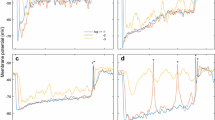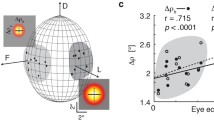Summary
-
1.
Monopolar cells of the first visual ganglion, the lamina, of the bee were recorded from and stained intracellularly.
-
2.
Several different response types to pulses of spectral light were found. The most common response type hyperpolarized in a phasic-tonic fashion. The tonic hyperpolarizing response frequently decreased gradually, but in some cases increased with lasting illumination. Some cells also gave a transient response to light-OFF. In contrast, one stained and several unstained cells showed depolarizing responses. Five cells exhibited spiking responses under normal physiological conditions.
-
3.
The V/log I-functions were steeper than those of the photoreceptors and, in some cases, had both rising and falling parts with increasing intensities. The spectral sensitivity obtained with the constant response method showed a peak in the green (510–535 nm) in most cells. A series of spectral flashes revealed an additional type with highest sensitivity in UV. Indirect evidence was found in one cell for spectral opponent processing.
-
4.
Two morphological types of monopolar cells were stained. These correspond well to Ribi's (1976) L1 and L2 cells, with some differences in detail. The most frequently stained cell type closely resembles his L2 type. All 3 stained spiking cells were of this type.
Similar content being viewed by others
References
Arnett DW (1972) Spatial and temporal integration properties of units in first optical ganglion of Dipterans. J Neurophysiol 35:429–444
Backhaus W (1991) Color opponent coding in the visual system of the honeybee. Vision Res 31:1381–1397
Backhaus W (1992) The Bezold-Brücke effect in the color vision system of the honeybee. Vision Res (in press)
de Souza JM, Ventura DF (1989) Comparative study of temporal summation and response form in hymenopteran photoreceptors. J Comp Physiol A 165:237–245
de Souza JM, Hertel H, Menzel R, Ventura DF (1987) Marking and recording of monopolar cells in the bee lamina. Brazilian J Med Biol Res 20:851–855
Guy RG, Srinivasan MV (1988) Integrative properties of second order visual neurons: a study of large monopolar cells in the dronefly Eristalis. J Comp Physiol A 162:317–331
Hardie RC (1978) Peripheral visual function in the fly. PhD Thesis, Canberra
Hateren JH van, Laughlin S (1990) Membrane parameters, signal transmission, and design of a graded potential neuron. J Comp Physiol A 166:437–448
Hertel H (1980) Chromatic properties of identified interneurons in the optic lobes of the bee. J Comp Physiol 137:215–231
Hertel H, Maronde U (1987) Processing of visual information in the honeybee brain. In: Menzel R, Mercer A (eds) Neurobiology and behavior of honeybees. Springer, Berlin, pp 141–157
Kien J, Menzel R (1977a) Chromatic properties of interneurons in the optic lobes of the bee. I. Broad band neurons. J Comp Physiol 113:17–34
Kien J, Menzel R (1977b) Chromatic properties of interneurons in the optic lobes of the bee. II. Narrow band and color opponent neurons. J Comp Physiol 113:35–53
Laughlin SB (1973) Neural integration in the first optic neuropile of dragonflies. I. Signal amplification in dark-adapted second-order neurons. J Comp Physiol 84:335–355
Laughlin SB (1976) Neural integration in the first optic neuropile of dragonflies. IV. Interneuron spectral sensitivity and contrast coding. J Comp Physiol 112:199–211
Laughlin SB (1981) Neural principles in the peripheral visual systems of invertebrates. In: Autrum H (ed) Handbook of sensory physiology, vol. VII/6B. Springer, Berlin Heidelberg New York, pp 133–280
Laughlin SB (1984) The roles of parallel channels in early visual processing by the arthropod compound eye. In: Ali MA (ed) Photoreception and vision in invertebrates. Plenum Press, New York, pp 457–481
Laughlin SB, Hardie RC (1978) Common strategies for light adaptation in the peripheral visual systems of fly and dragonfly. J Comp Physiol 128:319–340
Menzel R (1973) Spectral response of moving detecting and “sustaining” fibres in the optic lobe of the bee. J Comp Physiol 82:135–150
Menzel R (1974) Spectral sensitivity of monopolar cells in the bee lamina. J Comp Physiol 93:337–346
Menzel R, Backhaus W (1988) Color vision in honeybees: Phenomena and physiological mechanisms. In: Stavenga D, Hardie R (eds) Facets of vision. Springer, Berlin Heidelberg New York, pp 281–297
Menzel R, Blakers M (1976) Colour receptors in the bee eye — morphology and spectral sensitivity. J Comp Physiol 108:11–33
Menzel R, Ventura DF, Hertel H, de Souza JM, Greggers U (1986) Spectral sensitivity of photoreceptors in insect eyes: comparison of species and methods. J Comp Physiol A 158:165–177
Naka KI, Rushton WAH (1966) S-potentials from colour units in the retina of fish (Cyprinidae). J Physiol 185:536–555
Penisten DK (1988) Visual motion sensitivity in the fly medulla. PhD thesis
Ribi WA (1976) The first optic ganglion of the bee. II. Topographical relationships of the monopolar cells within and between cartridges. Cell Tissue Res 11:359–373
Ribi WA (1981) The first optic ganglion of the bee. IV. Synaptic fine structure and connectivity patterns of receptor cell axons and first order interneurons. Cell Tissue Res 215:443–464
Riehle A (1981) Color opponent neurons of the honeybee in a heterochromatic flicker test. J Comp Physiol 142:81–88
Shaw DR (1968) Organization of the locust retina. Symp Zool Soc Lond 23:135–163
Shaw DR (1984) Early visual processing in insects. J Exp Biol 112:225–251
Zettler F, Järvilehto M (1972) Lateral inhibition in an insect eye. Z Vergl Physiol 76:233–244
Author information
Authors and Affiliations
Rights and permissions
About this article
Cite this article
de Souza, J., Hertel, H., Ventura, D.F. et al. Response properties of stained monopolar cells in the honeybee lamina. J Comp Physiol A 170, 267–274 (1992). https://doi.org/10.1007/BF00191414
Accepted:
Issue Date:
DOI: https://doi.org/10.1007/BF00191414




